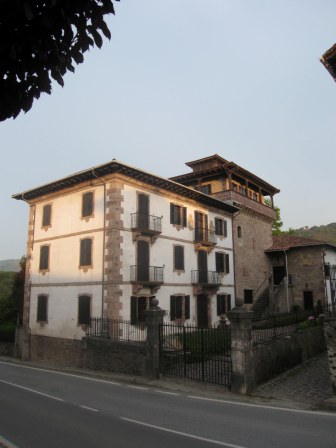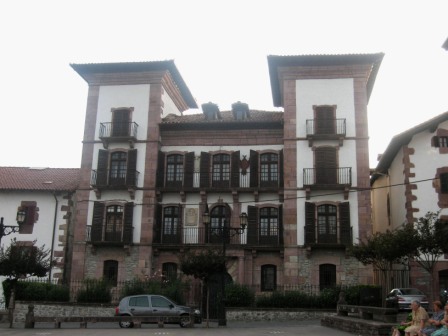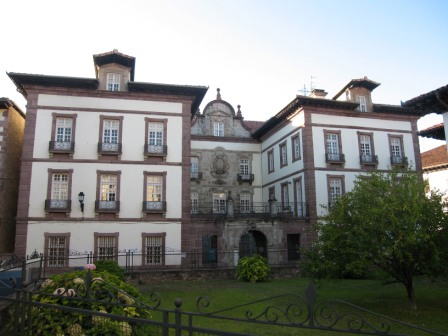5 June
Conferences
ON CULTURAL HERITAGE IN THE BAZTAN VALLEY
Image, prestige and lineage: houses and palaces in Baztan
Ms. Pilar Andueza Unanua
Chair of Navarrese Heritage and Art
The rich and varied collection of palaces and stately homes that dot the Baztan valley is directly related to the "Navarrese time of the XVIII century", a fortunate coinage given by Julio Caro Baroja to a socioeconomic phenomenon by which numerous Navarrese, especially from Baztan, left their homeland at the end of the XVII century and emigrated, settling mainly in Madrid, America and commercial cities such as Cadiz or El Puerto de Santa Maria. There, supporting each other by virtue of their common origin, friendship and kinship, they achieved positions of high responsibility in the service of the Spanish crown, both in the administration of the state and in the army, without lacking those who entered the top of the Church. Many of them also dedicated themselves with great success to business, combining in many occasions some activities with others, which allowed them to gather large patrimonies that were accompanied by a rapid ascent in the social scale, supported also by the nobility that gave them their birth. A good part of the fortune amassed by the Baztaneses reverted to their places of origin. The family left behind and the ancestral home occupied a privileged place among their concerns. For this reason, the remittance of wealth to Baztan was constant. In addition to increasing the properties, redeeming debts and providing for the women of the house, the reform of the solar house or its construction of new plant became a primordial element for many of them, which caused a construction fever to run through the valley. Not in vain did the new family building thus become the image of the family and the lineage and a symbol of prestige, capable, moreover, of surviving over time, beyond its inhabitants. But during the Age of Enlightenment not only numerous houses and palaces were built, but also several council and rectory houses, while not a few parishes received generous donations from their emigrant sons for their reconstruction, enlargement or endowment with altarpieces, sculptures and liturgical furnishings.
In the lands of Baztanes we find basically two types of domestic constructions corresponding to the Baroque period: on the one hand, that which follows the popular architecture of the area and develops the subject farmhouse, and on the other hand, a cultured and stately architecture, both of plastered and stone walls, which incorporates pilasters and columns in its front, a multitude of balconies with rich latticework, stone corbels, carved eaves with large overhangs, without forgetting, in both, the omnipresent coat of arms that speaks of the nobility of its inhabitants.
Among the first constructions, it is worth mentioning, for example, the Dorrea de Azpilkueta house, built at the request of the Bishop of Durango and Michoacán (New Spain) Martín de Elizacoechea, the Buztinaga de Erratzu, the manor of the Bishop of Pamplona Irigoyen y Dutari, the Hualde de Erratzu palace, the Indacoechea de Irurita house, to which the county of Guaqui is linked, as well as the Echeverzea de Amaiur house.

The Jauregia de Irurita palace exemplifies with its architecture, in which a late medieval tower merges with an eighteenth-century extension, the marriage of the owner of the palace with a man from Baztania who returned from America in the Age of Enlightenment.
In the second block of buildings we find the Echeverría or Lamiarrita house in Arizkun, erected in 1712 by Juan Tomás de Goyeneche, treasurer of the queen, as well as the Iturraldea house in Arizkun, the native house of Juan Bautista Iturralde, minister of Felipe V and marquis of Murillo, who ordered its construction next to the convent of the Poor Clares, also sponsored by him. Both have arcades on the ground floor leave.
Of great interest are also the palaces with stone facades, among which the Jarola de Elbete palace stands out, a building that was built in 1674 by Captain Miguel de Vergara y Borda, prototype of the entrepreneur who combined with rich results the degree program of the Indies with the militias. He was inspired by recently constructed buildings such as the Urdanibea house in Lesaka or the Apeztegui palace in Erratzu. But it also served as model in turn for the construction of the town hall of the valley a few years later and for the Datue palace, both in Elizondo. accredited specialization Also worthy of mention are the Ascoa palace in Elbete and the Arraztoa and Borda palaces in Amaiur, both built by the Borda family, a clan dedicated to business.
Typology typical of Baztan lands is the towered palace. These include the Reparacea palace in Oieregi, the Iriartea house in Erratzu and the house of the Gastón de Iriarte family in Irurita. Following this design, a man from Baztan, Pedro Fermín Goyeneche, a native of Garzáin, built the palace of Subiza in 1763, where one of his granddaughters married.

House of the Gastón de Iriarte family. Irurita
It followed the model of the house Iriartea of Erratzu, where its owner was born.
A However, the most outstanding example of palatial architecture in Baztan is the Arizkunenea house which, together with the Arozarena palace, both in Elizondo, are linked to the Arizcun lineage. They were sponsored by one of its members, Miguel de Arizcun who, settled in Madrid, achieved great fortune thanks to business, especially military seats, also receiving the degree scroll of Marquis of Iturbieta. He paid for both constructions, which were finished by 1740, and sent rich trousseaus to furnish both buildings.

Arizkunenea was built in the 1740s, next to the nearby Arozarena palace, at the request of Miguel de Arizcun, Marquis of Iturbieta, who emigrated to Madrid.
Among his businesses was the provision of ammunition for the army.
